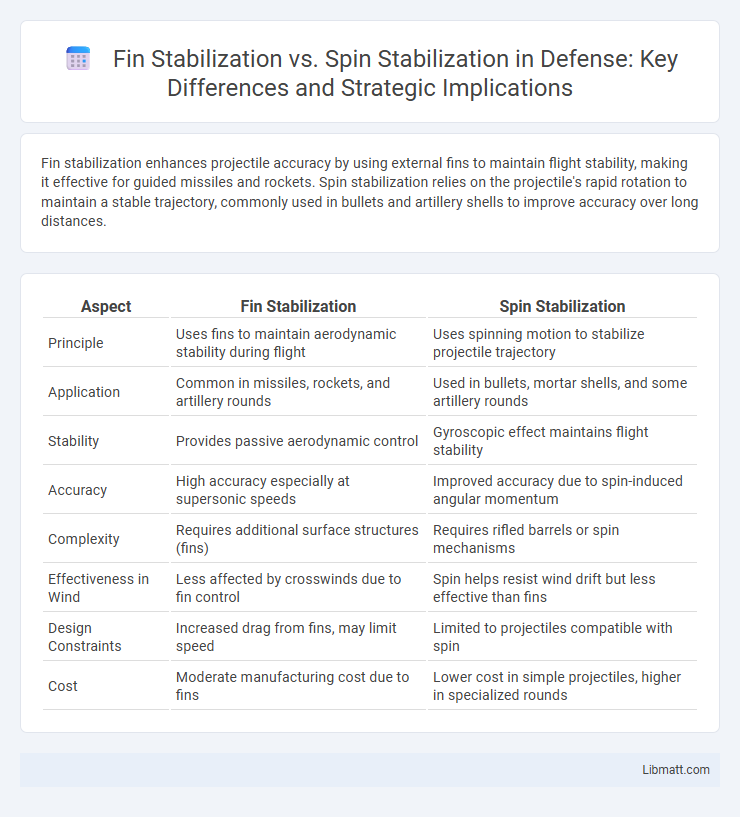Fin stabilization enhances projectile accuracy by using external fins to maintain flight stability, making it effective for guided missiles and rockets. Spin stabilization relies on the projectile's rapid rotation to maintain a stable trajectory, commonly used in bullets and artillery shells to improve accuracy over long distances.
Table of Comparison
| Aspect | Fin Stabilization | Spin Stabilization |
|---|---|---|
| Principle | Uses fins to maintain aerodynamic stability during flight | Uses spinning motion to stabilize projectile trajectory |
| Application | Common in missiles, rockets, and artillery rounds | Used in bullets, mortar shells, and some artillery rounds |
| Stability | Provides passive aerodynamic control | Gyroscopic effect maintains flight stability |
| Accuracy | High accuracy especially at supersonic speeds | Improved accuracy due to spin-induced angular momentum |
| Complexity | Requires additional surface structures (fins) | Requires rifled barrels or spin mechanisms |
| Effectiveness in Wind | Less affected by crosswinds due to fin control | Spin helps resist wind drift but less effective than fins |
| Design Constraints | Increased drag from fins, may limit speed | Limited to projectiles compatible with spin |
| Cost | Moderate manufacturing cost due to fins | Lower cost in simple projectiles, higher in specialized rounds |
Introduction to Projectile Stabilization Methods
Projectile stabilization methods ensure accuracy and flight stability by controlling rotational dynamics. Fin stabilization uses aerodynamic surfaces to maintain a projectile's orientation by leveraging airflow during flight, enhancing stability without induced spin. Spin stabilization imparts angular momentum through rifling or spin mechanisms, counteracting external disturbances and maintaining a steady trajectory.
What is Fin Stabilization?
Fin stabilization is a method used to maintain the stability and trajectory of rockets or projectiles by attaching aerodynamic fins to their rear section. These fins generate restoring forces that counteract undesired rotational motions, ensuring the projectile remains on its intended flight path. Your understanding of fin stabilization helps in distinguishing it from spin stabilization, which relies on rotational motion rather than external aerodynamic surfaces for stability.
How Spin Stabilization Works
Spin stabilization works by rotating a projectile around its longitudinal axis, creating gyroscopic forces that maintain its orientation and stability during flight. This continuous spinning counters external disturbances such as air resistance and gravity, ensuring your projectile follows a steady, predictable trajectory. In contrast to fin stabilization, spin stabilization relies on angular momentum rather than aerodynamic surfaces for stability.
Key Differences Between Fin and Spin Stabilization
Fin stabilization relies on aerodynamic surfaces to maintain a projectile's flight path, providing directional control through fins that generate lift and stabilize against yaw and pitch. Spin stabilization uses the gyroscopic effect created by the rapid rotation of the projectile to maintain orientation and resist external disturbances, enhancing accuracy without the need for aerodynamic surfaces. The key difference lies in fin stabilization's dependence on external aerodynamic forces versus spin stabilization's reliance on rotational inertia for maintaining trajectory stability.
Aerodynamic Principles Behind Each Method
Fin stabilization relies on aerodynamic surfaces attached to the projectile to generate restoring forces that keep your missile or rocket aligned with its flight path, counteracting perturbations by producing stabilizing aerodynamic torque. Spin stabilization achieves stability by imparting angular momentum to the projectile through rapid rotation, utilizing gyroscopic effects to maintain its orientation and resist external disturbances. Both methods exploit fundamental aerodynamic principles--fin stabilization uses lift and drag forces on control surfaces, while spin stabilization harnesses rotational dynamics to enhance flight stability.
Historical Development and Applications
Fin stabilization emerged in the early 20th century, revolutionizing projectile accuracy by using aerodynamic surfaces to maintain trajectory, notably in World War I artillery shells. Spin stabilization, dating back to rifled firearms in the 15th century, utilizes gyroscopic forces from rotating projectiles to enhance ballistic precision and has been crucial in missile guidance systems. Your understanding of these stabilization methods highlights their distinct historical roles: fin stabilization in modern rocketry and spin stabilization in firearms and space launch vehicles.
Performance Comparison: Accuracy and Range
Fin stabilization offers superior accuracy and extended range by providing aerodynamic stability through fins that reduce drift and maintain consistent trajectory. Spin stabilization improves accuracy by inducing gyroscopic stability, but generally offers less range due to aerodynamic drag caused by the spinning motion. Performance comparison reveals fin-stabilized projectiles excel in long-range precision, while spin-stabilized systems are effective for shorter-range applications with moderate accuracy requirements.
Advantages and Disadvantages of Each Technique
Fin stabilization provides precise aerodynamic control and improves flight stability by counteracting external disturbances, though it increases drag and complexity in design. Spin stabilization simplifies guidance systems and reduces weight due to the gyroscopic effect but offers less control during flight and is less effective at high speeds. Choosing between fin and spin stabilization depends on mission requirements such as maneuverability, accuracy, and aerodynamic conditions.
Modern Innovations in Projectile Stabilization
Modern innovations in projectile stabilization integrate advanced materials and computational fluid dynamics to enhance fin stabilization precision and adaptability. Spin stabilization, traditionally reliant on rifling-induced rotation, benefits from smart gyroscopic sensors and micro-electromechanical systems (MEMS) that optimize spin rates in real-time. Your projectile's accuracy and range improve significantly with these technological advancements, combining aerodynamic fin designs and adaptive spin control for superior flight stability.
Choosing the Right Stabilization for Your Application
Selecting between fin stabilization and spin stabilization depends on your projectile's speed and accuracy needs. Fin stabilization offers superior control at lower velocities due to aerodynamic surfaces, making it ideal for short-range applications. Spin stabilization relies on gyroscopic forces from projectile rotation, enhancing stability and precision at higher speeds, which benefits long-range targeting.
fin stabilization vs spin stabilization Infographic

 libmatt.com
libmatt.com